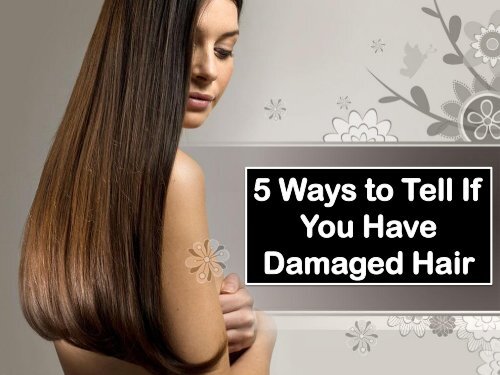5 Ways to Tell If You Have Damaged Hair
Many people facing hair damage issue but they don't know exactly what type of damage they have. In this presentation we discuss about the 5 most common hair damage issues. Find us online here for further details http://www.selectsalonstudios.com
Many people facing hair damage issue but they don't know exactly what type of damage they have. In this presentation we discuss about the 5 most common hair damage issues. Find us online here for further details http://www.selectsalonstudios.com
You also want an ePaper? Increase the reach of your titles
YUMPU automatically turns print PDFs into web optimized ePapers that Google loves.
5 <strong>Ways</strong> <strong>to</strong> <strong>Tell</strong> <strong>If</strong><br />
<strong>You</strong> <strong>Have</strong><br />
<strong>Damaged</strong> <strong>Hair</strong>
<strong>Damaged</strong> and unhealthy hair have their own looks and ways of behaving. Some<br />
people get used <strong>to</strong> how their hair feels and looks like and most likely ignore the<br />
glaring signs of unhealthy hair needing regular treatments. Visible signs like bald<br />
spots, patches of hair falling out, or hair thinning are easy <strong>to</strong> spot, but what<br />
about some lesser-known signs that can even more threatening for your hair<br />
health.
Split Ends<br />
Most commonly mistaken for frizzy hair, split ends occur when hair shaft gets<br />
split in two or three fragments. The ends are the oldest part of our hair which<br />
gets highly porous with time. This is why girls with naturally curly hair tend <strong>to</strong> oil<br />
their hair heavily. <strong>If</strong> your hair is thick and full at the roots, but quite thinner at the<br />
ends, then it’s obvious the ends are damaged.
Lack of Elasticity<br />
Healthy hair possesses high level of elasticity which results in the formation of its<br />
body, texture, and bouncing ability. The biggest concern with loss of elasticity is<br />
the difficulty in its treatment.<br />
To test for elasticity, wet a strand of hair and stretch it. <strong>If</strong> the strand breaks with<br />
just a little or no pull, then it needs more moisture. While if it stretches a bit and<br />
returns <strong>to</strong> its original position at release, then the elasticity level is normal. But if<br />
it gets stretched beyond that and then breaks, or feels soft or limp between the<br />
fingers, then there is a lack of protein. The point <strong>to</strong> understand is hair must have<br />
the perfect balance between protein and moisture which can best be attained by<br />
protein treatments.
High Porosity<br />
Porosity is the level of ease by which hair tends <strong>to</strong> absorb moisture and chemicals. <strong>You</strong> may<br />
have noticed that after oiling some parts of your hair become dry quickly as compared <strong>to</strong><br />
other areas which may still be moist or wet. This means the damaged hair are more porous<br />
or quick absorber than healthy hair. Applying chemicals regularly such as straighteners, hair<br />
gels, colors, etc. makes hair more porous.<br />
Apart from undergoing conditioning and protein treatments, you need <strong>to</strong> reduce the usage<br />
or <strong>to</strong>tally eliminate chemicals, dyes and styling products for some time.
Unruly and Hard Tangles<br />
Textured or styled hair are more vulnerable <strong>to</strong> tangling that straight hair. <strong>If</strong> you are<br />
doing everything right in detangling but still finding it hard <strong>to</strong> free unruly and dirty<br />
tangles, then it’s a possibility your hair must be damaged. The stubborn tangles<br />
can be a result of some of the issues discussed above: dry hair and split ends. Also<br />
if your hair lacks elasticity then it can easily break in the attempt <strong>to</strong> rescue from<br />
tangles. The best solution goes with trimming your hair short and frequenting<br />
more deep-conditioning.
Dry, Brittle, No Moisture<br />
Grab a couple of strands and run your fingers from the root <strong>to</strong> the tip. <strong>If</strong> the hair<br />
feels rough, then it’s a potential sign of dryness and damage. Do this test every<br />
time after a day of washing as sometimes the dryness can also result from the<br />
accumulation of chemical in hair. Dryness is also caused by some external fac<strong>to</strong>rs<br />
such as weather or even within the body reactions from certain medications and<br />
hormonal changes. But most often it is due <strong>to</strong> applying <strong>to</strong>o much heat, chemicals,<br />
and improper conditioning and moisturizing treatments.
Thank you for spending your quality time here. We will<br />
appreciate your suggestions and feedback. This short<br />
presentation is created on the behalf of Select Salon Studios.<br />
Stay connected with us through our contact information below.<br />
Address 1: 5221 Monroe St, Toledo, OH 43623<br />
Call: 419-309-0009<br />
Address 2: 3355 Briarfield Blvd, Suite A, Maumee,<br />
Ohio 43537<br />
Call: 419-309-0009<br />
Website: http://www.selectsalonstudios.com


















